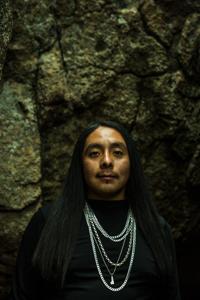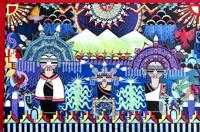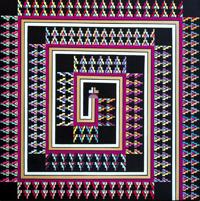For Lomayumtewa Ishii, art and heritage are two parts of the same whole.
Ishii is Hopi, of the Rabbit Tobacco Clan, and was born in Sichomovi on First Mesa—a place he travels often to see family and tend to his cornfield. His art, paintings with intricate geometrical patterns and deeply embedded symbolism, are rooted in Hopi ceremonies, teachings from his elders and the living things that surround him—corn, rainclouds, birds.
“Most of the paintings for this collection are coexisting with Sinom, that is, the people,” he says of his current exhibit at Flagstaff’s HeArt Box gallery, also titled Sinom, The People. “[It] is inspired by the Sinom as far as having encouraging words from your people, from your own community. And overall having them experience something where they can feel a sense of hope. Most of my inspiration comes from my heritage, my culture, hope as well.”
The artist has been painting and drawing since he was young, continuing to hone the craft throughout community college and while working his current job in the local hospitality industry.

Lomayumtewa Ishii's paintings are informed by his Hopi heritage, religious ceremonies and the teachings of his family members and elders. His art employs vibrant colors and intricate geometrical designs as a way to convey hope, beauty and peaceful-coexistence.
Painting, like many aspects of his life, demands careful balance—between his life in Flagstaff and his home on Hopi, his job at a hotel and his work farming his land, his daily life in the city and leaving to attend ceremonies—in order to create works that relay forms of joy.
“I really think about what my audience is going to see, how I am going to express myself through the works,” Ishii says. “In them is a sense of hope and joy, how you go through certain things and want to express them in a really positive manner and also have people view and express and have those kind of feelings too. That is what my paintings represent.”
The painting “Sonew Katsi,” or “Beautiful Life,” is of particular importance. In the piece, Ishii’s singular use of vibrant shades of blue is on full display, as are three kachina dolls which make up the focal point. Behind them the San Francisco Peaks, beside them stalks of corn stretch up as if dancing. Birds dot each corner of “Sonew Katsi,” a hummingbird and cardinal among them.
The painting tells the story of his life and that of family members, Ishii says. The three kachinas represent his three nieces, like daughters to him. The specific kachinas he chose to include in the piece represent, in part, the change from girl to womanhood.

In his painting 'Sonew Katsi, Beautiful Life,' artist Lomayumtewa Ishii makes three kachinas the focal point, together they represent his three nieces and their growth as young women.
“There is so much good energy from [my nieces] and I wanted to portray them as beautiful, elegant, intelligent and strong young women,” Ishii says. “[‘Sonew Katsi’] represents life, you see the animals, birds, the mountains—all of those things have life.”
The birds, significant in certain ceremonies, also take on the role of messengers.
“When we pray, we pray for everything, family, plants, and I feel like those birds are messengers of those prayers,” he says. “And the corn, it represents growth and posterity. We all go through different cycles of life like corn.”
Corn is a deciding part of Ishii’s art and life. Not only does he embed it into many of his paintings as representations of growth, cycles and maturing, he wakes up before dawn many mornings to drive many miles to tend to his own field, usually arriving just as the sun rises. A good harvest is the corn showing itself, the result of hard work and cultivating his connection to the earth and his heritage, he said. This then translates to painting.
“Getting my field was a big eye opener for me and helped me develop as a person as well as my style of art,” Ishii says. “It’s such a simple plant but it helped me to realize how woven into our culture it is and not just Hopi culture but in Indigenous culture in general. When I walk my field I think about those concepts and it makes me more connected to the land, because I am living it, I am doing it, it is part of me, so it makes that more meaningful for me and my art.”
Corn also inspires Ishii’s color palette, which also takes influence from the vibrant shades of turquoise and bright yellow that surrounded him as a child. Blue especially is prominent in his work, inspired by the blue corn he plants in his fields, the kernels often ranging from dark hues of purple and blue to baby blues.
The red corn too, Ishii points out, has a vast range: light pink, yellow, burgundy.
“So I think about those types of corn and the colors, and you can see that in my art, the vibrancy,” he says.
Here the artist mentions “Itaanuangwa” specifically. The painting, dominated by seemingly endless blues, shows two healthy corn stalks—the visual representation of Ishii’s ongoing lessons about the crop and its intricacies. It was the first piece he created when he got his field and not only shows the learning process therein but also serves as a metaphor for his own changes, the coming of maturity and cycles of life.

'Itaanuangwa, In Our Hearts,' represents Ishii's learning process when it comes to planting, tending to and harvesting corn. It also examines the plant metaphorically as a symbol for growth, posterity and cycles.
“In our hearts we pray for our well-being, nature and life. The two corn symbolize hope, prosperity and well-being,” he writes in his artist statement. “In dry farming, the corn endures rough elements only to become beautiful pieces of art. Similarly, we human beings are always adapting to our surroundings to make life meaningful. Through prayer, the little moisture coming their way gave them life is powerful and undeniably awesome.”
For the first two years or so, learning to farm was difficult. The techniques of dry farming presented a steep learning curve for Ishii, as did lessons on how to keep elk out of the field and the tired early mornings he spent driving to Hopi.
“It’s hard but it’s beautiful,” he says. “You’re doing it for the benefit of the people.”
This is where another critical pillar of art and life enter the framework, that is, family and elders whose stories are reflected back to them in Ishii’s art and without whose guidance learning about his traditions would not be possible. Ishii focuses on his mother, father, uncles and grandmother teaching him about Hopi religious ceremonies and how to plant and cultivate corn, inspiring him in both his art and day-to-day.
“This is a part of me,” he says. “Farming helps me spiritually and it helps me as a person. When I go to ceremonies, go home to Hopi to be in the Kiva, it helps me balance out my life. And your spirit is more energized, because basically you’re living in two worlds—the city where you do what you need to survive but also going back to your community.”
When he first began painting, Ishii says, he didn’t think about that, however—the practice was more for his own enjoyment.
“But growing up in a traditional household my parents taught us it was really important to be connected to your culture, through participation and ceremony, through expressing it through the visual arts,” he says. “I’ve always been geared toward the arts in being able to express my heritage, myself and some of the lessons I have learned. That is part of having my parents guiding me.”

The painting 'Kuwanwunu' by Hopi artist Lomayumtewa Ishii is a series of complex geometrical designs and symbols. The spiral shape in the painting represents a rainbow and the clouds at its center are painted blue and gold to represent male and female, the patterns on the edges represent ancestors as individual clouds and the life-giving powers of both. This particular piece took Ishii more than a year to complete.
Ishii thinks about the juncture of art and agriculture, painting and cultural heritage often, relating it to last year’s harvest when he filled a Marshall’s bag with corn for his grandma, giving still more to friends and relatives.
“Harvest, it brings so much joy. Because that is all your hard work and dedication and you want to share that with the people you love, to show them that you care for them and you think about them,” he says. “That’s also why my art is focused on my teachings and experiences and what it means to give corn, because you’re giving people hope and happiness because it comes from you, like the artwork comes from you too.”
To view Lomasumtewa Ishii’s art, visit www.theheartbox.space. The exhibit will also be viewable in person until Monday, Aug. 31 at 17 N San Francisco St.
Get local news delivered to your inbox!
August 29, 2020 at 05:49AM
https://ift.tt/31FELL8
Acrylic and corn: Artist Lomayumtewa Ishii discusses ‘Sinom, The People’ exhibit - Arizona Daily Sun
https://ift.tt/3gguREe
Corn


No comments:
Post a Comment